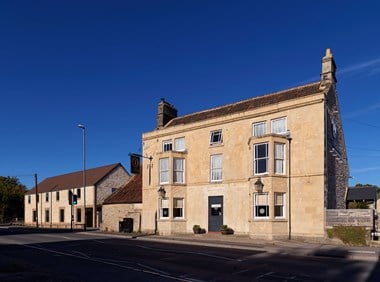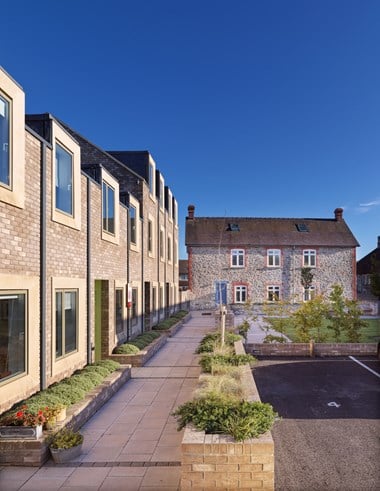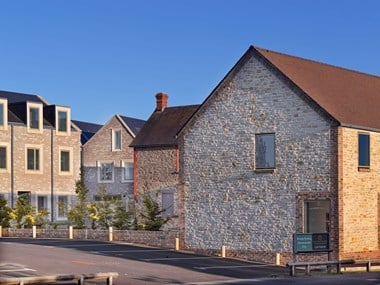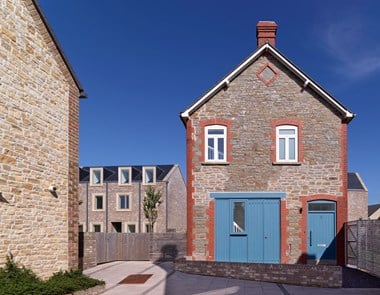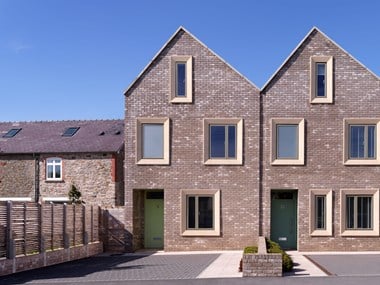Design Case Study: Temple Gardens, Temple Cloud, Bath and North East Somerset
The refurbishment and viable reuse of a listed pub, with a sensitive scheme of new housing and hotel development which fits effortlessly into its surroundings.
This case study is one of ten studies of new residential or mixed-use developments compiled in 2020 by Purcell on behalf of Historic England.
Project information
- Region: South West
- Type of development: Village infill site
- Location and postcode: Temple Cloud, Bristol, BS39 5EL
- Local planning authority: Bath and North East Somerset Council
- Architects: Archio
- Developer / land owner: Bath and Stratford Homes
- Number of residential units: 9
- Site area: 0.34 hectares
- Other uses: Hospitality (pub and hotel)
- Awards: Winner, RIBA South West Project Architect of the Year 2018; Winner, RIBA South West Regional Award 2018; Short-listed, British Homes Awards Small Development of the Year; Short-listed, AJ Housing Project of the Year (up to £10 million)
Description of development
This scheme comprises the refurbishment and alteration of the vacant Temple Inn public house along with the construction of ten lettable hotel rooms associated with the pub and nine new residential units, all with three to four bedrooms. Five of the new dwellings are in a terrace, two form a semi-detached pair and the final two dwellings are within a converted outbuilding of the pub. The scheme also includes hard and soft landscaping including a private courtyard for residents and separate car parking for the pub and residential units.
Heritage assets affected
The site includes the Grade II listed Temple Inn, a historic village pub the oldest parts of which date to the 17th century with 18th and 19th century alterations. The curtilage of the pub contained two outbuildings, one of which was demolished as part of the scheme and the other converted into two residential units. Adjacent to the site, on the opposite side of Temple Inn Lane is Temple Cloud Court House, a Grade II listed mid-19th century former court house and police station, now a private dwelling.
Planning context
There are no site-specific policies related to the site, however the public house had been vacant for some time and was deemed to be ‘at risk’. The development was considered against NPPF and Bath and North East Somerset (BANES) policies relating to sustainable development, the significance and setting of heritage assets, housing provision and good quality design.
Assessment of design qualities and relationship to historic environment
This development is located at the heart of the village of Temple Cloud on the brownfield site of a vacant public house, the Grade II listed Temple Inn. The developers identified an opportunity to secure the refurbishment and viable use of the pub through the addition of lettable hotel rooms, expanding the hospitality offer, and supported by bespoke new housing.
The scheme has arisen from careful consideration of the site constraints and opportunities including re-using one of the pub outbuildings for residential accommodation and using the lettable rooms building to screen the car parking and new houses from the main road.
The new buildings have been arranged in an informal arrangement reminiscent of various outbuildings the site held historically. Two of these outbuildings survived, both curtilage listed but neither of particular special interest. One has been retained and converted whilst the other has been demolished to allow sufficient new development to ensure the viability of the scheme and repair of the listed building.
The lettable rooms building, at two storeys, is subservient in scale and fully detached from the pub. The terrace of five dwellings parallel to the rear is part one and a half storeys and part two storeys with attic accommodation. The other pair of new dwellings, fronting Temple Inn Lane, is similarly two storeys with attic. These slightly taller elements are set sufficiently away from the three storey listed building so as not to compete. Furthermore, the varying scale of the building draws upon the vernacular character and informal planning of a site of this type.
The traditional pitched roof forms of the proposed buildings continue the deferential relationship with the listed building reflecting the simpler appearance of the outbuilding. However, the new buildings do not seek to be pastiche, holding their own with bold features, simple lines and material palette. Different aspects of the scheme respond to their context in different ways.
The lettable rooms building is perhaps the most traditional in its appearance and in keeping with other similar local buildings, being clad in stone and with a clay-tiled roof. The use of slender-framed glazing and brick detailing elevate the design.
The rear terrace and semi-detached pair have a more contemporary design through the use of bold dormers, asymmetrical gable windows and strong, contrasting architraves. The use of natural stone to clad all the new buildings was unviable, however this allowed for an innovative approach to be taken for the other new buildings. Although not a common local building material, a brick shade similar to that of Bath stone was selected. This ties the new buildings in with the stone buildings on the site and with the character of the local area.
Due to the uses within the scheme, a relatively large amount of surface car parking is required. This is broken into two separate zones to reduce their impact, one for the pub and one for the residences. The use of tarmac has been limited, with a fine, pale gravel used for the car parks softening and creating a more vernacular appearance. The scheme also includes a private green courtyard for the residential units, providing structure to the layout.
Key points
The impetus of the scheme has been to bring about the refurbishment and viable use of the listed pub, however in achieving this aim the architects have conceived a highly contextual, sensitive scheme of new housing and hotel development which fits effortlessly into its surroundings.
Underused or vacant sites within a settlement boundary offer excellent opportunities to enhance and reinforce village character. New development, including at increased densities, is often less controversial with local communities than edge of settlement expansion. The success of this scheme is in it contextual design, complementing the existing pub and local character in terms of its scale and material choices in particular. The scheme also offers more than just housing bringing a selection of tangible public benefits including the reopening and refurbishment of the village pub and providing long-term jobs in the hospitality sector for the local community.
Community engagement was an important part of the process, particularly as concurrently a larger, more contentious scheme was passing through the planning system. When consulted during the design process, the local community reacted positively to the proposals, in particular bringing a derelict site and building back into use and the material and form of the proposed buildings. Residual concerns remained around traffic and parking, however from a heritage perspective the scheme was deemed to have been highly successful by the Local Planning Authority, the community and by the architectural profession having been awarded or shortlisted for several industry awards.
Views of Temple Gardens
Please click on the gallery images to enlarge.
-
Design in the Historic Environment
Principles and case studies for good practice in design when making changes to the built historic environment.
-
Design in the Historic Environment: Case Studies
Download all ten case studies as a PDF document.
-
Design Case Study: Roussillon Park Chichester, West Sussex
A case study of design in the historic environment: Roussillion Park is a modern residential complex at the site of a former barracks in Chichester.
-
Wildernesse House Mews, Sevenoaks
Case study of a new mews-style development within the setting of a Grade II listed mansion and within an area of historic landscape.
-
Bourne Estate, Holborn, London
An award-winning residential extension on a Grade II listed urban estate, bringing together old and new through quality detailing and landscaping.
-
Design Case Study: 168 Upper Street, Islington
A case study of an imaginative reinstatement of a missing corner building in Islington that reproduces the original facade.
-
Fairmile Hospital
Case study of the re-development of a former hospital on the edge of a rural village with new homes designed as distinctive groups.
-
Garden Quarter, Caversfield
Case study for design in the historic environment of the sensitive redevelopment of a former Royal Air force site into a residential community.
-
Church Fields, Boston Spa
A design case study featuring a residential extension to the edge of an historic village that interprets traditional architectural forms.
-
Timekeepers Square, Salford
Case study of a redevelopment that recreates the vernacular Georgian terrace and urban grain within the setting of a listed church.
-
Welsh Streets Liverpool 8
Case study of an ambitious and popular scheme that converts hundreds of derelict Victorian terraced houses.


